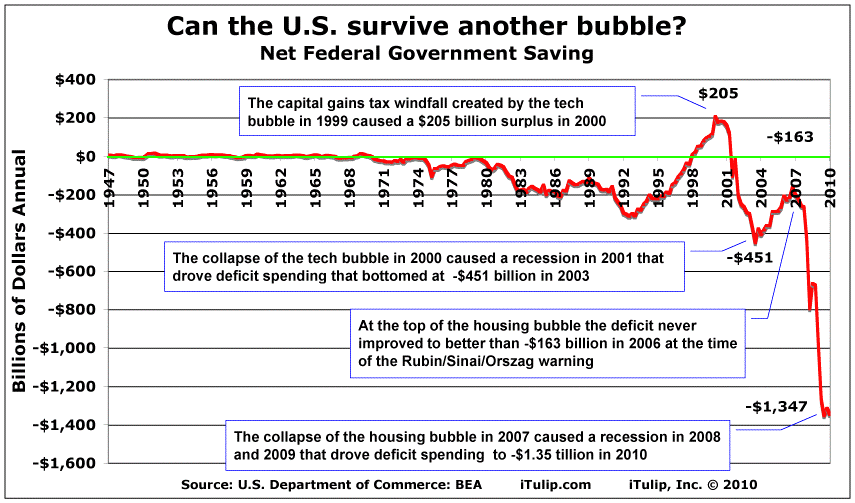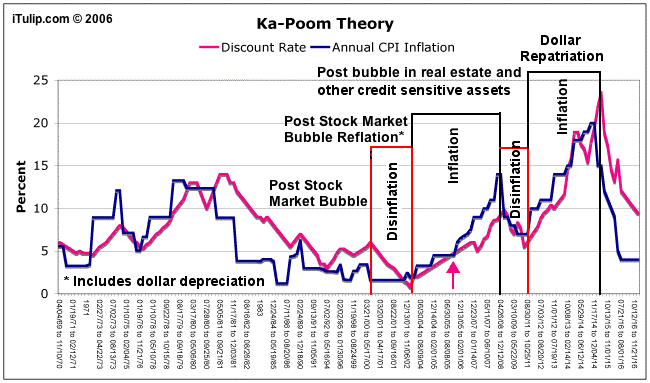
Six years ago today the Brookings Institution released a report Sustained Budget Deficits: Longer-Run U.S. Economic Performance and the Risk of Financial and Fiscal Disarray that speculates the outcome that we outlined in our 1999 theory of a final asset price deflation and reflation cycle that pushes the U.S. economy over the edge into a debt and currency crisis.
The U.S. federal budget is on an unsustainable path. In the absence of significant policy changes, federal government deficits are expected to total around $5 trillion over the next decade. Such deficits will cause U.S. government debt, relative to GDP, to rise significantly. Thereafter, as the baby boomers increasingly reach retirement age and claim Social Security and Medicare benefits, government deficits and debt are likely to grow even more sharply. The scale of the nation's projected budgetary imbalances is now so large that the risk of severe adverse consequences must be taken very seriously, although it is impossible to predict when such consequences may occur.
The adverse consequences of sustained large budget deficits may well be far larger and occur more suddenly than traditional analysis suggests, however. Substantial deficits projected far into the future can cause a fundamental shift in market expectations and a related loss of confidence both at home and abroad. The unfavorable dynamic effects that could ensue are largely if not entirely excluded from the conventional analysis of budget deficits. This omission is understandable and appropriate in the context of deficits that are small and temporary; it is increasingly untenable, however, in an environment with deficits that are large and permanent. Substantial ongoing deficits may severely and adversely affect expectations and confidence, which in turn can generate a self-reinforcing negative cycle among the underlying fiscal deficit, financial markets, and the real economy:
* As traders, investors, and creditors become increasingly concerned that the government would resort to high inflation to reduce the real value of government debt or that a fiscal deadlock with unpredictable consequences would arise, investor confidence may be severely undermined;
* The fiscal and current account imbalances may also cause a loss of confidence among participants in foreign exchange markets and in international credit markets, as participants in those markets become alarmed not only by the ongoing budget deficits but also by related large current account deficits;
* The loss of investor and creditor confidence, both at home and abroad, may cause investors and creditors to reallocate funds away from dollar-based investments, causing a depreciation of the exchange rate, and to demand sharply higher interest rates on U.S. government debt;
• The increase of interest rates, depreciation of the exchange rate, and decline in confidence can reduce stock prices and household wealth, raise the costs of financing to business, and reduce private-sector domestic spending; more...
Where are we six years later?The adverse consequences of sustained large budget deficits may well be far larger and occur more suddenly than traditional analysis suggests, however. Substantial deficits projected far into the future can cause a fundamental shift in market expectations and a related loss of confidence both at home and abroad. The unfavorable dynamic effects that could ensue are largely if not entirely excluded from the conventional analysis of budget deficits. This omission is understandable and appropriate in the context of deficits that are small and temporary; it is increasingly untenable, however, in an environment with deficits that are large and permanent. Substantial ongoing deficits may severely and adversely affect expectations and confidence, which in turn can generate a self-reinforcing negative cycle among the underlying fiscal deficit, financial markets, and the real economy:
* As traders, investors, and creditors become increasingly concerned that the government would resort to high inflation to reduce the real value of government debt or that a fiscal deadlock with unpredictable consequences would arise, investor confidence may be severely undermined;
* The fiscal and current account imbalances may also cause a loss of confidence among participants in foreign exchange markets and in international credit markets, as participants in those markets become alarmed not only by the ongoing budget deficits but also by related large current account deficits;
* The loss of investor and creditor confidence, both at home and abroad, may cause investors and creditors to reallocate funds away from dollar-based investments, causing a depreciation of the exchange rate, and to demand sharply higher interest rates on U.S. government debt;
• The increase of interest rates, depreciation of the exchange rate, and decline in confidence can reduce stock prices and household wealth, raise the costs of financing to business, and reduce private-sector domestic spending; more...

We are much, much worse off. Now we're in a balance sheet recession, with interest rates near zero, dependent on government spending to grow the money supply.
One more crash away from Ka-Poom

Today while finishing up our latest long article we noticed that our new analysis of the risks to U.S. debt and the dollar puts the 10-year Treasury bond in the range of 24% within five years. Our 2006 forecast was for a 20% discount rate by 2015. Unless the yield curve is inverted at the time, the new estimate we generated using a completely independent and unrelated analysis agrees with our old model that produced the Ka-Poom chart above.
Naturally, the most disturbing aspect of this is that the new analysis agrees with the model we created in 1999 and updated seven years later. We keep waiting for the model to break down again as it did in 2003 due to the housing bubble. Now it appears that the housing bubble didn't invalidate Ka-Poom but instead phase-shifted the event out by eight or nine years, from 2006/2007 to 2014/2015. But because these types of events usually occur immediately before or after national elections, 2012/2013 is a more likely target date for our trade. We’ll let you know when we’ve ironed out the details.
iTulip Select: The Investment Thesis for the Next Cycle™
__________________________________________________
To receive the iTulip Newsletter/Alerts, Join our FREE Email Mailing List
To join iTulip forum community FREE, click here for how to register.
Copyright © iTulip, Inc. 1998 - 2010 All Rights Reserved
All information provided "as is" for informational purposes only, not intended for trading purposes or advice. Nothing appearing on this website should be considered a recommendation to buy or to sell any security or related financial instrument. iTulip, Inc. is not liable for any informational errors, incompleteness, or delays, or for any actions taken in reliance on information contained herein. Full Disclaimer




Comment